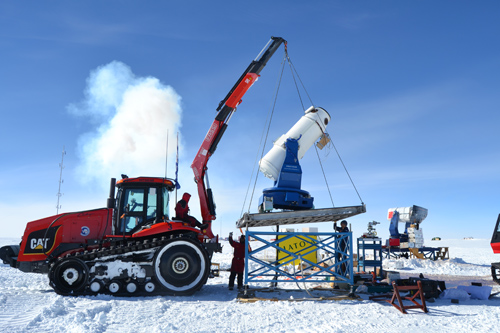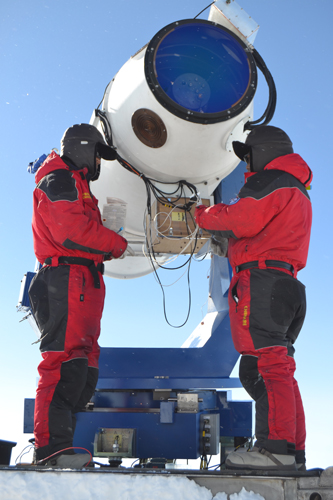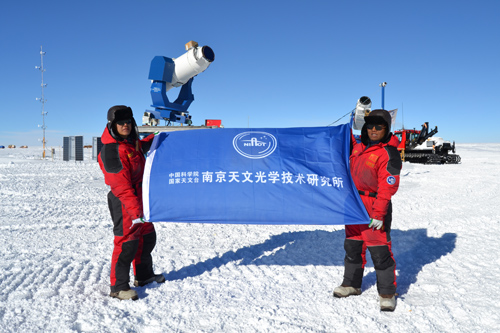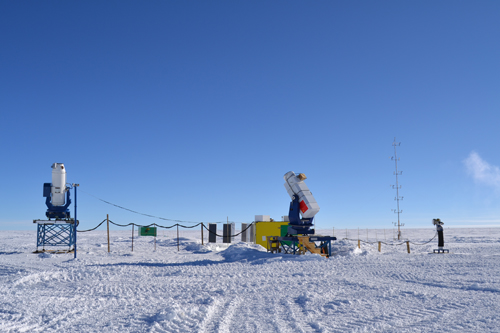At the blooming season, Victorious melody was played. On April 10th, the Chinese thirty-first Antarctic expedition team that had successful completed the expedition task returned to Shanghai base pier by " Xuelong" polar research ship. Vice-prof. Du Fujia and Dr. Li Zhengyang who were from the Nanjing Institute of Astronomical Optical and technology, CAS, triumphant returned. Vice-director Gong Xuefei made a special trip to meet them.
The 31st. Chinese Antarctic Research expedition team had set out from Shanghai on October 30th. 2014, and on November 18th. was cordially received by President Xi Jinping on " Xuelong". After arriving at the "Zhongshan" station, both unloading on sea ice and materials preparing for the inland expedition were successful completed ahead of time. Inland expedition team (Kunlun team) left Zhongshan Station on Dec. 15th. 2014. The team met the snowstorm, Albino weather, blowing snow and other miserable weather on the way to Dome A. The total distance from Zhongshan station to Dome A is 1250Km.The expedition team had successfully arrived at Kunlun station on the afternoon of Dec.30th,2014. Du Fujia and Li Zhengyang start to install and maintain the telescopes on the next day, Dec.31st. The conditions in Kunlun station is very harsh. The altitude is 4087 meters, the temperature can reach to -40 degree and the air pressure nearly half of sea level. The two teammates who had the indomitable perseverance, strong sense of responsibility and mission had overcome lots of difficulties, such as the tight schedule, hard tasks, short of hands. With the help of other teammates, the Antarctic expedition astronomical tasks were successfully completed after 23 consecutive days of hard working. In the morning of Jan. 23rd. 2015, the expedition team left for the Zhongshan Station and arrived at Zhongshan station in the morning of Feb. 7th. This inland expedition stayed at Kunlun station for 23 days, which was the longest expedition period. They experienced many troubles during the installation, such as the failure of equipment, effects of altitude reaction.
Every Antarctic research teammate had a lofty ideal, and worked hard to achieve it. Although it was the second trip to the Kunlun station for Du Fujia and Li Zhengyang (their first trip was the 28th. Chinese Antarctic Expedition in 2011/2012), and they had been very familiar with it, the Antarctic astronomical expedition task was not easy at all. It was the hardest one comparing with other expedition team. Two young researchers had never been afraid to deal with the difficulties, and taken the pressure as a driving force to keep working day and night under the harsh conditions of minus 40 degrees, high altitude anoxia and struggling to walk. They were in a race against the time. They only took a short break when tired and sleepy, then worked again after short break. Du Fujia had to install, test and troubleshoot in a narrow cabin with special heavy clothes. Li Zhengyang had been coughing for several days due to long-term outdoor working. "Not to leave the front line on account of minor wounds ". Both of them had weight loss due to physical exertion. Since long-term outdoor work and the ultraviolet irradiation, their cheeks looked like having coated with a layer of bronze. They said: they had the strong support of all Chinese Antarctic astronomical researchers and their sincerely expectation. We dared not have the slightest slack. We had no choice but to complete the task! They keep firmly in mind the spirit of NIAOT, patriotic spirit, truth-seeking, innovation incentive, hard work. And these spirit inspire them to successfully carry out an assignment--the thirty-first Chinese Antarctic expedition astronomical missions.
This main missions of 31st expedition team include: The AST3-2--the second sets of Antarctic Survey Telescope was successful set up. And this telescope also was tested and debugged on-site and remote. The AST3-1 --the first sets of three Antarctic Survey Telescopes was repaired and the CCD also exchanged. The PLATO-A --automatic energy and communication system was maintained and updated. The updated CSTAR telescope was installed. The 15 meter high automatic weather station was installed. The transportation vibration data was collected on their way back. Now AST3-2 was been operating. It should be facing new challenges in the long Antarctic winter.
The Antarctic Survey Telescope -- AST3-2 and AST3-1 that developed for the first time in China were the automatic and unattended operation, which were designed and developed by the researchers from Nanjing Institute of astronomical optical & technology. It was planned to set up 3 sets with different filters on Dome A, Antarctic, which all had 68 cm primary mirror in diameter, 50cm pupil in diameter, and the spatial resolution of 1 arc-second. The third set would be installed in the next few years.
AST3 was a "Pathfinder" which were one of the major national scientific and technology infrastructure constructions --Chinese KunLun Antarctic Station. Precious experiences were gained during its development, operation and maintenance by Nanjing Institute of Astronomical Optics & Technology, National Astronomical Observatories, Purple Mountain Observatory and other related units. A good foundation was also laid for developing of Antarctic Astronomy in “13th. 5 years”.

installing of AST3-2

adjusting of AST3-2

photo of Du fujia and Li zhengyang

AST3-2(left) AST3-1(center) CSTAR(right)